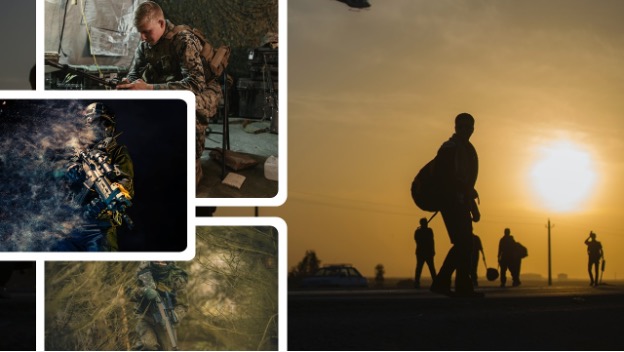
The Evolution of Intelligence Operations in Support of Irregular Warfare
Sal Artiaga – Irregular Warfare Practitioner
Irregular warfare (IW), deeply interwoven with cultural, political, and sociological factors, has historically relied on the agility and adaptability of intelligence operations. As the fabric of warfare has evolved from the dense jungles of Vietnam to the digital frontlines of Ukraine, so too has the nature of intelligence shifted, from human-centric insights to technology-driven reconnaissance. Moving forward, the fusion of advanced technological innovations with intrinsic human understanding will redefine the essence of intelligence in IW, making it a more potent force in navigating the complexities of future unconventional conflicts. By delving into the distinct epochs of Vietnam, Afghanistan, and Ukraine, we can discern the shifting sands of intelligence in support of IW and envision what the future might hold. Many will claim that the future of intelligence lies in technology and this claim has taken the front stage in the past, but it was unequivocally refuted with many mishaps that could have been prevented. Let’s look at the evolution of intelligence and see what the future ahead looks like for it.

Intelligence in Support of Irregular Warfare
Intelligence, in the context of IW, can be envisioned as the eyes and ears that illuminate the shadowy, often nebulous landscape of unconventional conflicts. At its core, intelligence goes beyond mere information gathering; it encompasses the deep understanding, processing, and analysis of data to discern patterns, motives, and vulnerabilities of adversaries who often shun traditional battle lines. In IW, where the lines between combatants and civilians blur and adversaries use asymmetry to their advantage, precise and actionable intelligence becomes the linchpin of effective operations. It equips forces with the nuanced understanding required to navigate the complexities of non-linear battlefields, ensuring that actions are both strategically sound and tactically adept. Without robust intelligence, operations in IW are akin to navigating treacherous waters blindfolded, emphasizing its paramount importance in these intricate theaters of conflict.
A Rude Awakening to Asymmetry
In the dense jungles of Vietnam, the United States grappled with a type of warfare that defied conventional wisdom. Vietnam’s dense foliage and labyrinthine terrains were more than just physical challenges. They were emblematic of the clandestine warfare the United States found itself immersed in. The ghostly presence of the Viet Cong, often melting seamlessly among civilians, required a paradigm shift in intelligence. Here, the Phoenix Program was born—a Central Intelligence Agency brainchild aiming to dismantle the Viet Cong’s covert infrastructure using informants, wiretaps, and captured documents. The initiative’s mixed results emphasized the indispensable role of human intelligence (HUMINT) in such conflicts, but it also underscored the moral quagmires and the difficulty of drawing clear lines in IW.
The Mirage of Technological Omnipotence
Several decades after the Vietnam experience, as the world entered the new millennium, the conflict in Afghanistan’s harsh terrains became emblematic of the blend of age-old warfare tactics and the digital era’s innovations. With the advent of cutting-edge technology, intelligence operations witnessed a metamorphosis. The skies above Afghanistan, once the domain of birds and stars, became populated with advanced drones, transmitting invaluable, detailed aerial imagery and enabling real-time monitoring of both urban centers and isolated mountainous regions. Meanwhile, signals intelligence (SIGINT) underwent significant enhancements. Sophisticated electronic equipment, stationed both on the ground and in orbit, constantly intercepted a flood of communications, from cellular conversations to encoded messages, painting a detailed tapestry of the adversary’s intentions and movements.
Yet, amidst this digital transformation, the ancient socio-cultural fabric of Afghanistan posed challenges reminiscent of epochs past. The nation, with its complex mosaic of tribes, clans, and shifting allegiances, defied easy categorization or prediction. In such a context, while drones could provide a bird’s eye view of the terrains and SIGINT could pierce through the veil of communication channels, truly grasping the intricate tribal nuances, understanding local sentiments, and deciphering the layered cultural allegiances necessitated a more organic approach. The indispensable value of HUMINT agents on the ground, embedded sources within communities, and liaisons with local leaders became starkly evident. These human operatives served as the bridge between advanced tech and ground realities, translating data into actionable insights.
Like so, Afghanistan became a poignant testament to a timeless truth: while technological advancements can redefine the scope and scale of intelligence, the nuanced, deeply human understanding of a region and its people remains paramount.
The Chessboard of Hybrid Warfare
Fast-forward to Ukraine, and the world witnessed Russia’s enigmatic hybrid warfare. It was not the first time Russia employed these techniques, as it employed some of them in the Russo-Georgian War in 2008, but it was the first time that the entire world paid attention. Russia’s hybrid warfare approach seamlessly wove conventional operations, guerilla tactics, cyber intrusions, and a disinformation blitzkrieg. The annexation of Crimea, followed by the tumult in Eastern Ukraine, signaled a new era of IW—one where intelligence would grapple with distinguishing fact from orchestrated fiction. Decoding the complex mosaic of state actors, mercenaries, proxies, and cyber warriors became the central challenge. Intelligence in this realm wasn’t just about gathering data; it was about piercing through a smokescreen of deliberate chaos. In 2022, the world bore witness to the declassification of intelligence by the U.S. to prevent Russia from controlling the narrative of the so-called “Special Operation.” This declassification opened the eyes of the world and presented a very different perspective from what the Russians tried to project. In this way, it acted as a torch illuminating the truth amid the purposeful shadows of misinformation.
A Synthesis of Tech and Human Insight
As we stand on the edge of tomorrow, the role of intelligence in IW seems destined for another transformation. Advanced artificial intelligence algorithms may sift through vast amounts of data, while human operatives ensure the contextual relevance of this data. Biotechnologies might offer novel ways of gathering intelligence, while space becomes a new frontier for reconnaissance. However, the essence will remain unchanged: understanding human terrain. Each conflict zone, be it in the dense jungles of Southeast Asia, the rugged mountains of Afghanistan, or the urban centers of Eastern Europe, has its unique human fabric. Deciphering this will be the perennial challenge and the undying essence of intelligence operations in irregular warfare.
In summary, tracing the arc of intelligence operations from Vietnam’s dense foliage to Ukraine’s digital frontlines provides a profound understanding of the evolution of intelligence. While methodologies and tools evolve with time, the quest for contextual, human-centric understanding in the realm of IW remains a constant. True art in intelligence lies not just in gathering information but in deciphering the stories, motives, and aspirations woven within it.
